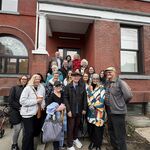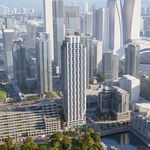I fail to see your reasoning as to why more room for bus traffic is needed around STC. Looking at a map of the area, Sheppard isn't any more convenient of a parking spot than STC - as a matter of fact I'd argue the opposite. STC for better or for worse was designed to be accessed from the 401 as easily as possible. This is helped by having an off ramp off of McCowan directly into the parking lot of the mall and designing the onramps onto McCowan to easily funnel people south to the Mall. Now it is true that a lot of bus routes will be stopping by STC, however almost none of them get in the way of car traffic.
This green area is where the bus terminal is proposed to be, and while it is admittedly surounded by the exit path cars take to return back to the 401, building separation between that route and the busses should not be too difficult especially since for the most part, bus traffic will be pulled towards Ellesmere meanwhile cars are typically going to head north towards the 401. The two modes are going their own separate ways and can easily be separated.
As for Agincourt vs Sheppard-McCowan, I fail to see the difference, while Agincourt isn't a terminus, its nonetheless close enough that there really isn't a difference between the two sites either way. The next station after Agincourt is Kennedy, so people travelling to Midtown or Danforth have an easy transfer where their trips on the Stouffville Line won't be any slower than on Line 2, and SSE has so few stations that they won't be missing out on much. STC as previously mentioned is a giant parking lot, most of which won't be redevelopped for a long time, so if you need to head to STC you might as well drive, which leaves the only benefit of a parking lot at Sheppard-McCowan being... better access to Lawrence East?
I feel like you're shooting a bit too far. While removing car dependency is a noble goal, unfortunately getting everyone onto busses and out of cars in the suburbs is optimistic at best. Public transport is unfortunately often seen (for good reason) as a balancing game of how much slow down people are willing to accept compared to just driving when it comes to staying out of traffic and having more freetime, and for many having to use a feeder bus, and "getting people onto busses" will only get you so far. Toronto has admittedly done a great job with its bus services with many vital corridors like Finch and Sheppard having busses as frequently as every 5 minutes, but simultaneously it could be argued that this is as good as can get with the bus service, and for those who don't take the bus are probably the types of people who are willing to accept driving to a station to use public transport, but not getting to the station via public transport, be it busses or LRT, and this is the dilemma we're faced with. We can either have increased bus service with the chance of getting them off the road, or we can build parking which is guaranteed to significantly reduce the amount of journeys spent on the road.
Its not meant for the station but its still good for the station. The distance from the eastern lots to present day McCowan is give or take identical to the parking lots at Finch to Finch Station, so if we are to turn them into officially paid parking lots fo the TTC Station like we did with the parking lots at VMC, they could do a good job handling the parking demand for the new extension no problem.




